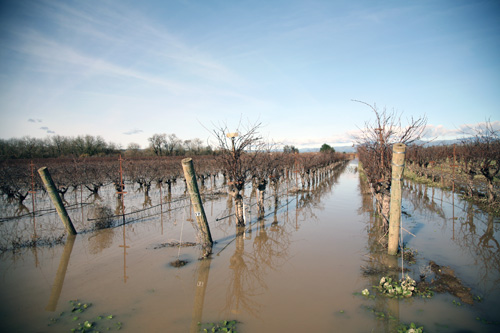
Lake Sonoma is at over 100 percent capacity
While December’s torrential rainfall might have been off-putting to some wine country tourists, the deluge was a boon to agriculture and the environment according to local farming experts.
The evidence that there was plentiful rainfall in 2012 is apparent with Lake Sonoma sitting at more than 100 percent of its water supply pool. Throughout Windsor, Sebastopol and Healdsburg, rainfall in 2012 practically doubled that of 2011, year-over-year.
Windsor recorded 26.56 inches of rain in 2011, versus 40.69 inches in 2012, while Sebastopol recorded 21.17 inches of rain in 2011, versus 38.58 inches in 2012, and Healdsburg recorded 20.67 inches of rain in 2011, versus 40.83 inches in 2012.
Behind Warm Springs Dam, Lake Sonoma, as of Jan. 7, was at 103.9 percent capacity of its 246,000 acre-feet water supply pool. The dam has an additional capacity within its flood control pool of 146,000 acre-feet.
All this rain is beneficial according to Farm Bureau executive director Lex McCorvey.
“Farmers’ and ranchers’ ponds and reservoirs are filling up earlier in the year,” McCorvey said. “This creates less water demand in the spring and takes pressure off the Russian River and its tributaries. It also stimulates vegetative growth earlier in the season, which is good for invested producers.”
From a grape perspective, Nick Frey, President of the Sonoma County Winegrape Commission, was in agreement with McCorvey.
“Everything’s good,” Frey said. “The rains have recharged the soil profile.”
“We have reservoirs filled and, with the cold weather, the buds stay in dormancy. If the weather were warmer and the buds came out of dormancy we’d have problems. Cold and rain have been good for the grapes.”
Frey did express some concern for farmers of produce other than grapes.
“If you had citrus or some winter vegetables you might not be so good,” he said, adding that if the green tissue were to freeze, there could be problems.
But McCorvey at the Farm Bureau maintained that he hasn’t heard of anyone facing problems stemming from the cold yet this winter.
“We’re not hearing about any negative impacts from the cold weather we’ve had,” he said. “It’s come in limited spurts of time and we’ve had no significant crop impacts.”
As far as McCorvey was concerned there was only good news so far in this winter’s conditions.
“After three years of drought conditions, it’s a banner year like this that’s going to help carry us through a few more years of limited supply,” he said. “It’s recharged the aquifers in the region and it’s going to have long term impacts for agriculture and fish.”








